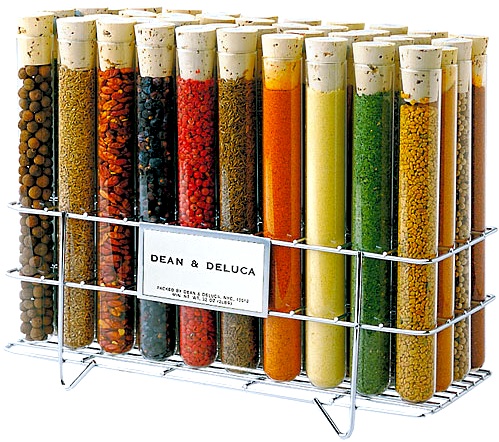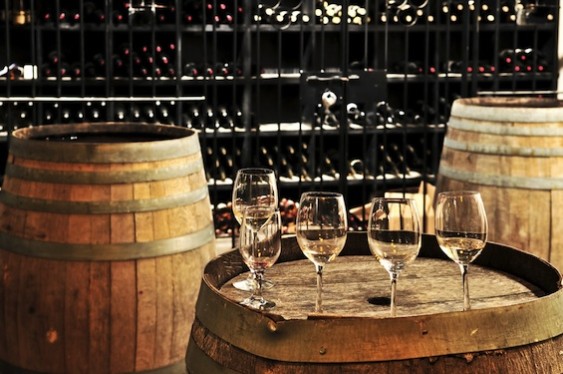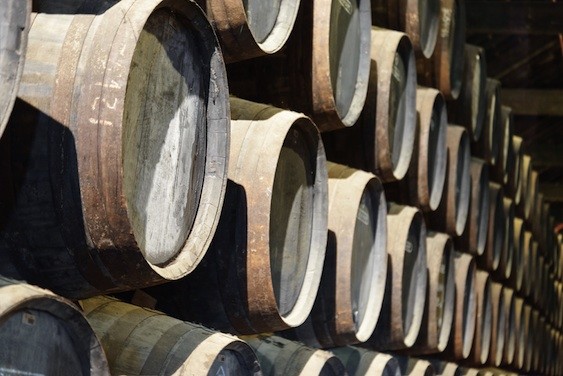When it comes to winemaking, what kind of oak barrel you use to ferment or age your wine can be just as important as what kind of grapes you use. Fermenting and/or aging wine in oak does all kinds of wonderful things to it, like imparting delicious flavors, providing structure and aging potential and more. In fact, many winemakers refer to their oak barrels as a kind of “spice rack” with which they can tweak the flavors of their wine.

Winemakers often refer to oak barrels as their “spice rack.” Photo source: Dean & Deluca.
If you’ve visited a high-end winery, chances are they’ve paraded you through their barrel room proudly pointing out the fancy French oak barrels they use. Maybe you thought to yourself, “Great, they’re from France, so what? Don’t we have oak here in the U.S.?”
Yes, we’ve got lots of oak here, and it’s even white oak, like the French kind, but the species is different. Wineries are very careful about what kind of oak they use (and many do indeed use American oak), because the kind of oak you use will infuse different flavors to your wine.
Overall, oak can give wines aromas of vanilla, caramel, chocolate, coffee, smoke and spice, among others, depending on where it comes from, how much it was toasted, whether it is new or old, and a variety of other factors, though I’ll cover that in another article.
In terms of winemaking, you’re likely to see one, or a combination of, three kinds of oak. Here are their basic characteristics and the flavors they are typically thought to imbue the wine with.

Which kind of oak you use will determine the flavors of your wine.
French Oak
This is the big man on campus. It’s the most expensive kind of oak to use (barrels typically cost around $800-$1,000 each). The species tends to be either quercus robur, or the rarer but more sought-after quercus petraea. This kind of white oak has a very tight grain that allows for slower oxidation, and thus the more gradual suffusion of flavors. At the same this kind of oak is higher in tannin than American oak, so it tends to lend the wines more structure and elegance, but without toughening the wine up with those bitter flavors tannins sometimes get a bad rap for.
As for tasting notes, French oak is thought to produce subtler flavors of cedar and spices like nutmeg and cinnamon.
American Oak
The most typical species you’ll find for barrels here is quercus alba, which grows in the eastern part of the U.S., though quite a bit comes from Missouri, and you’ll also find it in California, Oregon, Minnesota and Wisconsin. The grain in this wood tends to be a bit looser, so the wine oxidizes faster and takes on the tasting notes of the wood quicker as well.
The dominant aromas most folks pick out from American oak influence, which has more vanillin compounds than French, are coconut, with touches of vanilla and something slightly tropical like banana. American barrels are also more of a bargain at around $400 each.

Pay attention to the kind of oak next time you’re in a winery’s barrel room.
Hungarian and Slavonian Oak
Eastern European oak is also quercus robur, thus it is quite similar to French oak, and comes at a fraction of the cost (around $400-$600 per barrel), so more wineries are looking into using it. The flavor profile here tends to be a bit nuttier and more rustic compared to French oak’s refinement. Because Hungarian oak tends to have higher levels of eugenol compounds, people often note more intense flavors of spice and clove as well as coffee.
And just in case you thought it was all about the oak, different kinds of wood have been, and still are in some parts, used to make and age wine today. Some Italian and Austrian wines use cherry or acacia wood, while wineries in California used to use redwood in the 19th century, and those in Argentina’s Cafayate region traditionally used carob wood. And if you’ve had the Greek wine Retsina, it gets its distinctive evergreen flavor from barrels that have been coated with pine resin.

